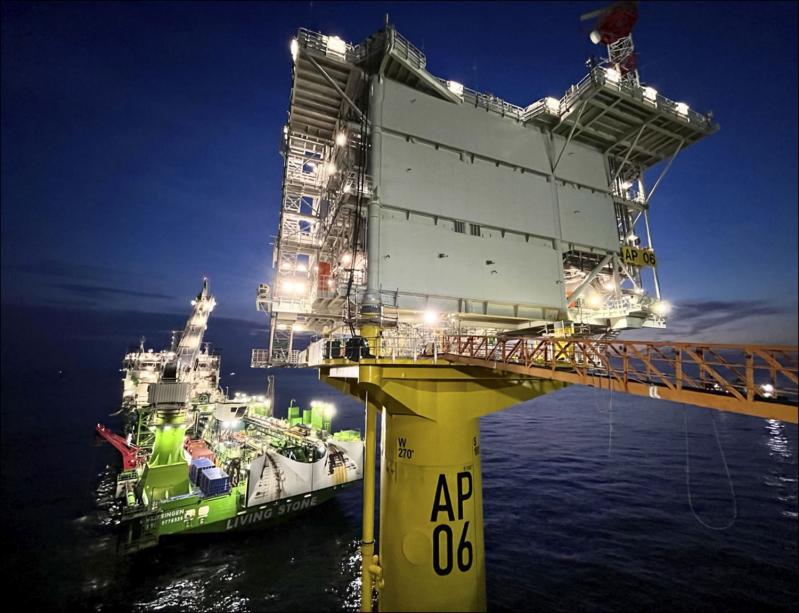It was just 18 months ago that Gov. Kathy Hochul, at Stony Brook Southampton College, uttered the words “Today, at long last, we flip the switch and turn on the future.” Surrounded by federal, state, Suffolk County, and East Hampton Town officials, the governor was on the South Fork to mark the completion and operation of the South Fork Wind farm, the first commercial-scale offshore wind farm in the United States.
Today, the Trump administration is systematically switching that future off in favor of the past, in the form of fossil-fuel energy, the burning of which climate scientists are near united in warning is warming the planet and risking irreversible impacts.
On Friday the federal Transportation Department canceled $679 million earmarked for projects to support the development of offshore wind, such as upgrades to terminals and ports. An August court filing indicates that the Interior Department will rescind federal approval for the Maryland Offshore Wind Project, which is not yet under construction but is to feature up to 114 turbines.
The summer saw a flurry of activity aimed at killing a nascent industry that its proponents say has brought millions of union-labor hours and thousands of jobs with the promise of many more. In July, the federal Interior Department announced the end of what it called “preferential treatment for unreliable, subsidy-dependent wind and solar energy,” and in August launched investigations into bird deaths caused by wind farms. The federal Bureau of Ocean Energy Management rescinded regulations outlining renewable energy lease sales early last month.
On Aug. 7, BOEM’s acting director issued a “director’s order” to Orsted North America’s head of asset management ordering the company to “halt all ongoing activities related to the Revolution Wind Project on the outer continental shelf to allow time for it to address concerns that have arisen during the review that the department is undertaking.”
Revolution Wind is a 65-turbine installation situated in federal waters on the outer continental shelf adjacent to the 12-turbine South Fork Wind farm, around 35 miles off Montauk Point. Having received final federal approval from BOEM last year, construction of Revolution Wind was 80-percent completed at the time of the order halting it, with all of its foundations and 45 of 65 turbines installed.
Orsted, a Danish energy company, and Skyborn Renewables jointly own both wind farms, Skyborn having acquired a 50-percent stake from Eversource Energy one year ago. The developers say that South Fork Wind can generate electricity sufficient to power around 70,000 average-size houses, while Revolution Wind, under 20-year power purchase agreements, was to send electricity equivalent to power more than 350,000 residences to Connecticut and Rhode Island.
“BOEM is seeking to address concerns related to the protection of national security interests of the United States and prevention of interference with reasonable uses of the exclusive economic zone, the high seas, and the territorial seas,” according to its letter to Orsted, though it provided no details as to how the wind farm would jeopardize those interests.
Orsted is “evaluating all options to resolve the matter expeditiously,” according to an Aug. 22 statement from the developer, “with the aim being to proceed with continued project construction toward [a commercial operation date] in the second half of 2026.” The project was employing “hundreds of local union workers,” according to Orsted’s statement, while the developer’s offshore wind projects in the United States had accounted for around four million labor hours.
The federal government’s move followed BOEM’s April stop-work order directed at Empire Wind 1, an 80,000-acre, 816-megawatt wind farm under construction in the New York Bight. The following month, Equinor, the Norwegian energy company that is developing Empire Wind 1, announced that the agency had informed it that construction could resume. According to published reports, the Trump administration allowed construction to proceed only after Governor Hochul agreed to approve new gas pipelines in the state, which she denied.
State government officials, trade unions, and environmental advocates have condemned the administration’s moves, casting their criticism in economic rather than environmental terms.
On Monday, Labor Day, Governor Hochul, with her counterparts in Massachusetts, Connecticut, Rhode Island, and New Jersey, issued a joint statement decrying the administration’s stance. More than 5,000 workers, many of them union members, “are directly engaged with building this new American industry,” they said of offshore wind, “with many thousands more manufacturing products across 40 states that will help lead to a new era of U.S. energy independence.”
Offshore wind projects, they said, represent years of planning, billions in private investment, “and the promise of tens of thousands of additional jobs. They are revitalizing our ports, strengthening our supply chains, and ensuring that America — not our competitors — leads in clean energy manufacturing and innovation.” The governors called on the administration to “uphold all offshore wind permits already granted and allow these projects to be constructed.”
“The U.S. markets operate on certainty,” the governors noted. Canceling already-permitted projects “sends the worrisome message to investors that the work can be stopped on a whim, which could lead them to decide to either not finance different projects or impose higher interest rates that would ultimately place a bigger burden on taxpayers.”
Melissa Parrott, executive director of Renewable Energy Long Island, said in an Aug. 25 statement that the order to halt construction of Revolution Wind “represents a dangerous assault on America’s energy security, economic competitiveness, and environmental future. . . . As with the stop-work order that was issued (and subsequently lifted) for the Empire Wind project in April, the Bureau of Ocean Energy Management has failed to provide any reasoning behind their decision, other than concerns related to ‘national security.’ “ Halting construction of Revolution Wind, she said, is “legally questionable and reeks of fossil fuel influence.”
“Clawing back this money so close to Labor Day is a slap in the face to our incredible union work force, who are ready to build out the electric generation we so desperately need,” Alicia Gene Artessa, director of the New York Offshore Wind Alliance, said in a statement. “The list of people who will be hurt by these actions is long. The union workers who will have to find new jobs, the ratepayer who will face higher bills relying on volatile foreign energy sources, and the communities that would have seen the ripple effects of this increased economic development.”
Bonnie Brady, executive director of the Long Island Commercial Fishing Association and a staunch opponent of offshore wind farms, called the Trump administration’s moves “wonderful” and expressed a hope for “more clawbacks and eventually remands and vacating of permits.” Previously granted permits, she said, “were most likely fraudulent. They ignored fishing communities, ecosystems, marine mammals, national security, marine safety, and the entire health of the ocean in general.”
Offshore wind farms, she said, “should’ve never been sited how they were and I hope they are made to take their industrial garbage back with them.”
“While I share concerns about offshore wind’s costs and its reliance on taxpayer subsidies, the fact is Sunrise Wind has already been debated, has bipartisan support, and is nearly 50-percent complete,” Representative Nick LaLota said in an email Wednesday evening. “Canceling it now would waste billions already spent, cost over 1,000 good-paying jobs, and leave foundations rusting offshore without delivering a single benefit to Suffolk families.”




